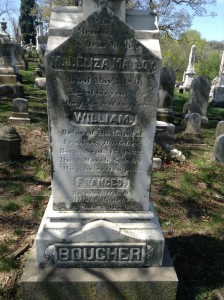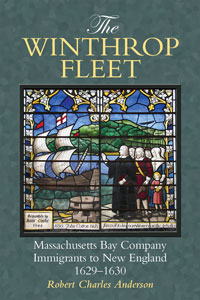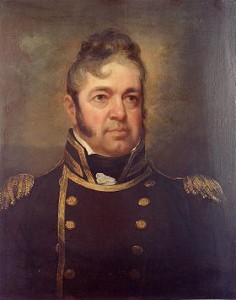 My cousin Connie recently sent me a photo of a young woman and asked me if I thought it might show her grandmother (and my great-great-aunt) Constance Boucher Burch (1887–1977). I’m inclined to think it does, given the provenance as well as the (rather unscientific) fact that this young woman has a family look: in features and coloring she reminds me of my grandmother Pauline Glidden Bell (1903–1968). (Click on images to expand them.) Continue reading Organizing a family reunion: Part Three
My cousin Connie recently sent me a photo of a young woman and asked me if I thought it might show her grandmother (and my great-great-aunt) Constance Boucher Burch (1887–1977). I’m inclined to think it does, given the provenance as well as the (rather unscientific) fact that this young woman has a family look: in features and coloring she reminds me of my grandmother Pauline Glidden Bell (1903–1968). (Click on images to expand them.) Continue reading Organizing a family reunion: Part Three
Category Archives: Family Stories
A considerable legacy in genealogy
 Samuel Gardner Drake was not a likely candidate to become the author of a multitude of historical works. Born on a farm in Pittsfield, New Hampshire, in 1798, he was not an eager pupil in his youth. “His aversion to school, when a little urchin,” as John H. Sheppard put it, “was particularly strong.” Drake recalled his initial dread of the school room: “My first impressions of that school were anything but pleasant. Being naturally very timid, I was sadly frightened at the stern look of the master. To learn my lessons seemed a desperate undertaking, and it was a long time before I could believe and feel I was not in danger of being annihilated.” Continue reading A considerable legacy in genealogy
Samuel Gardner Drake was not a likely candidate to become the author of a multitude of historical works. Born on a farm in Pittsfield, New Hampshire, in 1798, he was not an eager pupil in his youth. “His aversion to school, when a little urchin,” as John H. Sheppard put it, “was particularly strong.” Drake recalled his initial dread of the school room: “My first impressions of that school were anything but pleasant. Being naturally very timid, I was sadly frightened at the stern look of the master. To learn my lessons seemed a desperate undertaking, and it was a long time before I could believe and feel I was not in danger of being annihilated.” Continue reading A considerable legacy in genealogy
Family plots
 A colleague and old friend delights in killing people off: that is, finding the death and burial information of ancestors and other family members. When we are content to list a relative as having been born and later married, with no end date or place in our record-keeping, we are forgoing information that might explain biographical mysteries. By focusing on our direct ancestry without sparing a glance to collateral relatives or unexplained members of a household, we might well be overlooking the answer to an intractable research problem. I recently made the rounds of many of the cemeteries where my relatives are buried, but one that I did not visit this winter led me, years ago, to a break-through on my matrilineal line. Continue reading Family plots
A colleague and old friend delights in killing people off: that is, finding the death and burial information of ancestors and other family members. When we are content to list a relative as having been born and later married, with no end date or place in our record-keeping, we are forgoing information that might explain biographical mysteries. By focusing on our direct ancestry without sparing a glance to collateral relatives or unexplained members of a household, we might well be overlooking the answer to an intractable research problem. I recently made the rounds of many of the cemeteries where my relatives are buried, but one that I did not visit this winter led me, years ago, to a break-through on my matrilineal line. Continue reading Family plots
A sense of place and name
 The question from the previous post was: “What if John Smith and Mary Brown lived in Barnstable but Abigail Smith and Harry Carey were married at Sandwich?” Barnstable and Sandwich are right next to each other, so why would this raise a red flag?
The question from the previous post was: “What if John Smith and Mary Brown lived in Barnstable but Abigail Smith and Harry Carey were married at Sandwich?” Barnstable and Sandwich are right next to each other, so why would this raise a red flag?
Although this example involves an early nineteenth-century wedding (1816), and the rules of posting banns and other restrictions of earlier centuries were becoming less common, in New England towns there was still a strong tie to church and community. Girls married in the church to which their families belonged. John and Mary (Brown) Smith belonged to the church in Barnstable – what would their daughter be doing getting married in Sandwich? Continue reading A sense of place and name
“The Good lord direct us”: a New England love quadrangle, 1648-49
 In December 1648, Lucy (Winthrop) Downing sent her nephew John2 Winthrop a letter full of family news: her husband, Emmanuel Downing, had been at the birth of John’s baby half-brother, Joshua, the week before, and “I belleeue our cosen Dorithe Simonds is nowe wonne and weded to Mr. Harrison the Virginia minister.” Sounding at once like a modern-day gossip and a character in Pride and Prejudice, Mrs. Downing also noted that her daughter Lucy would probably soon marry: Continue reading “The Good lord direct us”: a New England love quadrangle, 1648-49
In December 1648, Lucy (Winthrop) Downing sent her nephew John2 Winthrop a letter full of family news: her husband, Emmanuel Downing, had been at the birth of John’s baby half-brother, Joshua, the week before, and “I belleeue our cosen Dorithe Simonds is nowe wonne and weded to Mr. Harrison the Virginia minister.” Sounding at once like a modern-day gossip and a character in Pride and Prejudice, Mrs. Downing also noted that her daughter Lucy would probably soon marry: Continue reading “The Good lord direct us”: a New England love quadrangle, 1648-49
Organizing a family reunion: Part Two
The organizers of the William Boucher reunion are starting with incomplete information about the family, as often happens. My cousins Cheryl and Connie and I all have lists of William Boucher’s descendants, but of course these lists are more accurate about Boucher’s children – Willy, Sophia, Freddie, Oscar, Frank, Imogene, Pauline, Victor, Josephine, Willy, Josephine, Gertrude, Louis, Frances, Marie, Pauline, Ernest, Carlos, Florence, Emile, Constance, and (yes) Emile and Constance – than about modern-day descendants. How best to find today’s Boucher family? Continue reading Organizing a family reunion: Part Two
“Very serviceable”: Maidservants in New England, 1638-41
 Young men and women of relatively high status, including the children of close relatives, passed through the households of the Winthrops and their friends: it was a rite of passage. Continue reading “Very serviceable”: Maidservants in New England, 1638-41
Young men and women of relatively high status, including the children of close relatives, passed through the households of the Winthrops and their friends: it was a rite of passage. Continue reading “Very serviceable”: Maidservants in New England, 1638-41
The Great Migration: Top-down, bottom-up
 The activities of the Massachusetts Bay Company in 1629-30 were uniformly organized from the top down. The Company either purchased or hired the vessels to carry the passengers and provisions. The passengers themselves, and especially the critically important professionals such as ministers and soldiers, were recruited by the Company leaders. Continue reading The Great Migration: Top-down, bottom-up
The activities of the Massachusetts Bay Company in 1629-30 were uniformly organized from the top down. The Company either purchased or hired the vessels to carry the passengers and provisions. The passengers themselves, and especially the critically important professionals such as ministers and soldiers, were recruited by the Company leaders. Continue reading The Great Migration: Top-down, bottom-up
“The place where you are”: letters to New England, 1631-36
 As I read through the third volume of the Winthrop Papers, one of the Winthrop correspondents I have most enjoyed is Edward Howes, described succinctly in a footnote as a “student of law, alchemist and mystic, clerk to [John1 Winthrop’s brother-in-law] Emmanuel Downing, [and] friend of the younger John Winthrop.” (Volume 2, p. 226) I find myself looking forward to Howes’ letters’ salutations, and to the mixture of folk wisdom, political intrigue, and religious fervor I find within their pages. At times Howes and John2 Winthrop sound like the young men they were, not far removed from university punning; in other letters, Howes can be quite formal and business-like as he fulfills commissions for the Winthrops and the Downings. Continue reading “The place where you are”: letters to New England, 1631-36
As I read through the third volume of the Winthrop Papers, one of the Winthrop correspondents I have most enjoyed is Edward Howes, described succinctly in a footnote as a “student of law, alchemist and mystic, clerk to [John1 Winthrop’s brother-in-law] Emmanuel Downing, [and] friend of the younger John Winthrop.” (Volume 2, p. 226) I find myself looking forward to Howes’ letters’ salutations, and to the mixture of folk wisdom, political intrigue, and religious fervor I find within their pages. At times Howes and John2 Winthrop sound like the young men they were, not far removed from university punning; in other letters, Howes can be quite formal and business-like as he fulfills commissions for the Winthrops and the Downings. Continue reading “The place where you are”: letters to New England, 1631-36
Using heraldry for genealogical research

I have had two good personal experiences with heraldry — and no bad ones.
When I was developing the West Indian ancestry of my ancestress, Susanna (Heyliger) Bainbridge, I found that her grandson (my great-grandfather) had drawn up an elaborate coat of arms for her husband, Commodore William Bainbridge, based on the arms of an unrelated Bainbridge family, quartering the arms of an unrelated Taylor family. (The Commodore’s mother was Mary Taylor. For an explanation of quartering arms, see this Wikipedia article.) Included in this heraldic disaster as a single quartering were the supposed arms of the Heyliger family. And, as it turned out, they were valid arms — though not for the Heyliger family. Continue reading Using heraldry for genealogical research
